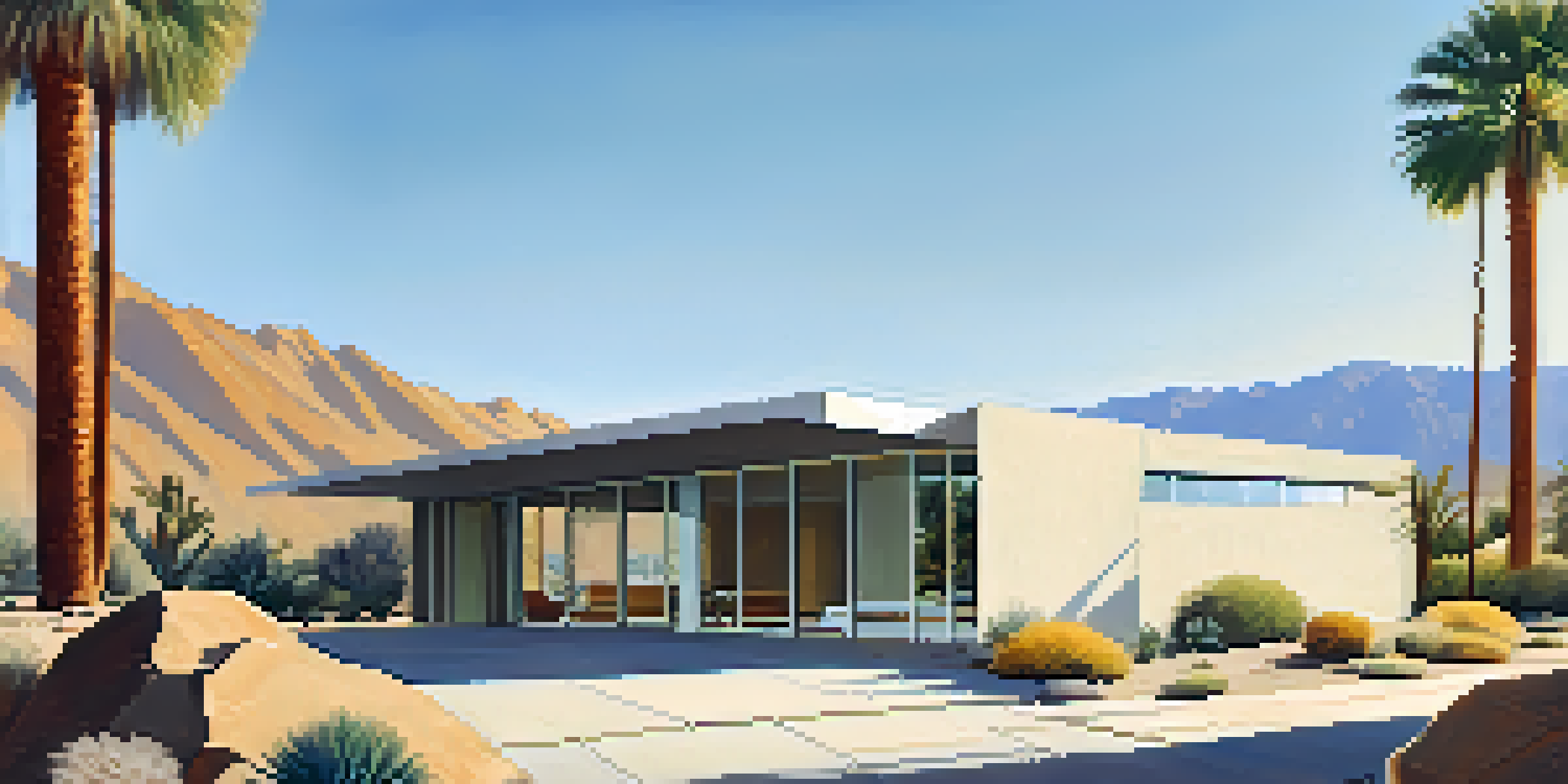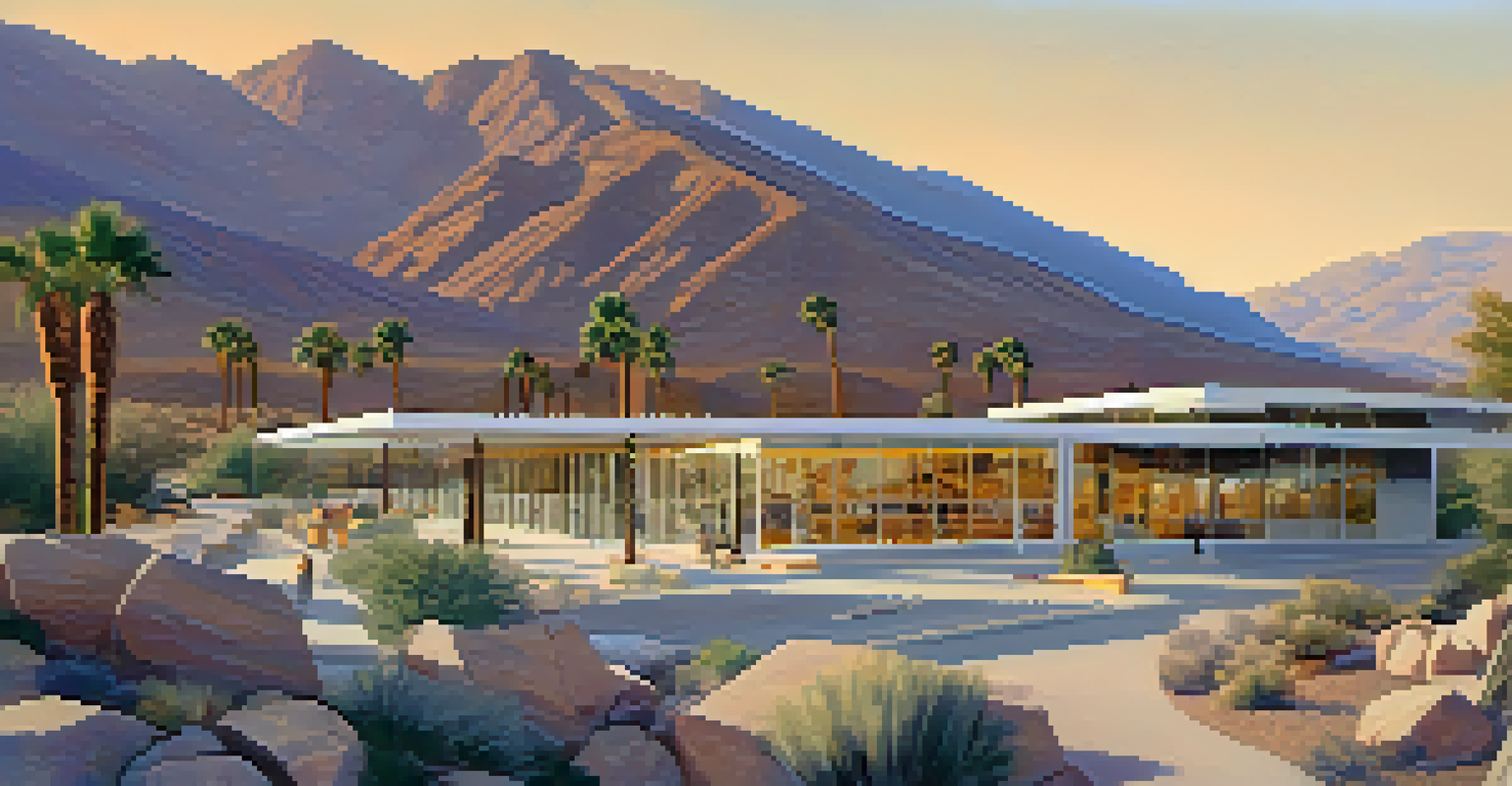Desert Modernism: Unique Structures in Palm Springs

What is Desert Modernism? An Overview of the Style
Desert Modernism is an architectural style that emerged in the mid-20th century, primarily in Palm Springs, California. This style is characterized by its clean lines, open spaces, and a seamless connection between indoor and outdoor living. Architects sought to create structures that harmonized with the desert landscape, utilizing materials like glass, steel, and concrete to reflect the natural surroundings.
Architecture is the art of how to waste space.
The movement was heavily influenced by the region's climate and geography, which led to the incorporation of features such as large windows and overhangs to provide shade. Iconic architects, including Richard Neutra and Albert Frey, played pivotal roles in defining this aesthetic. Their innovative designs not only provided comfort but also celebrated the beauty of the desert landscape.
Desert Modernism remains a significant part of Palm Springs’ cultural identity, attracting architecture enthusiasts and tourists alike. With each unique structure, visitors can experience the creativity and vision that these architects brought to life, making the desert a canvas for architectural expression.
Key Characteristics of Desert Modernism Architecture
One of the most striking features of Desert Modernism is the emphasis on large glass windows and walls, which allow natural light to flood the interiors. This design choice blurs the boundaries between the inside and outside, making the stunning desert vistas a part of everyday life. Additionally, low-slung roofs and flat planes are commonly seen, contributing to a sense of horizontal expansion that mirrors the landscape.

Another hallmark of this style is the use of natural materials, such as stone and wood, which add warmth and texture to the modern aesthetic. Architects often incorporated desert flora into their designs, creating a sense of cohesion with the environment. These elements not only enhance the visual appeal but also promote sustainability by using locally sourced materials.
Desert Modernism Defined
Desert Modernism is an architectural style that emerged in mid-20th century Palm Springs, characterized by clean lines and a strong connection between indoor and outdoor living.
Moreover, many Desert Modernist homes feature outdoor living spaces, such as patios and pools, that encourage residents to embrace the warm climate. These areas serve as extensions of the home, inviting relaxation and social gatherings while providing a cool retreat from the sun. This lifestyle-focused design approach is at the heart of what makes Desert Modernism so appealing.
Notable Architects of Desert Modernism
Desert Modernism owes much of its identity to a group of visionary architects who dared to challenge conventional design norms. Richard Neutra is perhaps the most famous, known for his iconic Kaufmann Desert House, which beautifully integrates indoor and outdoor spaces. His work exemplifies the principles of modernism while celebrating the unique desert environment.
The best architecture is not necessarily the most expensive, but the one that fits best with its surroundings.
Another key figure is Albert Frey, whose designs often featured innovative materials and techniques. Frey’s work, including the Frey House II, showcases an artistic approach to architecture that harmonizes with the natural landscape. His ability to blend modern design with the rugged beauty of the desert is a testament to the creativity of this architectural movement.
Lastly, we can't overlook the contributions of John Lautner, whose unique structures, like the Elrod House, pushed the boundaries of what was possible in residential design. Lautner's work exemplifies the idea of creating structures that feel as if they were born from the earth itself, merging seamlessly with their surroundings. Together, these architects shaped the narrative of Desert Modernism and left an indelible mark on Palm Springs.
Iconic Examples of Desert Modernism in Palm Springs
Palm Springs is home to numerous iconic examples of Desert Modernism, each telling its own story through architecture. One standout is the famous Kaufmann Desert House, designed by Richard Neutra in 1946. This masterpiece not only exemplifies modernist principles but also offers breathtaking views of the surrounding mountains and desert landscape.
Another notable structure is the Palm Springs Aerial Tramway Valley Station, designed by Albert Frey. This building cleverly integrates with the mountainous backdrop while offering visitors panoramic views of the Coachella Valley. Its innovative design reflects the essence of Desert Modernism by merging functionality with aesthetics.
Key Architects Shaping the Style
Visionary architects like Richard Neutra, Albert Frey, and John Lautner played pivotal roles in defining Desert Modernism through innovative designs that harmonize with the desert landscape.
Lastly, the Elrod House, designed by John Lautner, is a stunning example of how architecture can harmonize with nature. Perched on a rocky hillside, the house features a striking circular design and expansive glass walls, allowing residents to feel as if they are living among the desert itself. These iconic structures exemplify the creativity and beauty of Desert Modernism.
The Role of Desert Modernism in Palm Springs Culture
Desert Modernism is not just about architecture; it plays a significant role in the cultural fabric of Palm Springs. The city's identity is intertwined with this unique design style, attracting artists, filmmakers, and musicians who find inspiration in its beauty. Events like Modernism Week celebrate this architectural heritage, drawing visitors from around the world to appreciate its significance.
Moreover, the style has influenced the local lifestyle, with many residents embracing the indoor-outdoor living concept that defines Desert Modernism. This cultural shift encourages a relaxed, laid-back approach to life, where spending time outdoors and enjoying nature becomes a central theme. Cafes, galleries, and shops often reflect this aesthetic, further embedding it into the city’s culture.
As Palm Springs continues to evolve, Desert Modernism remains a vital part of its identity. The structures not only stand as historical landmarks but also as symbols of innovation and creativity that resonate with both locals and visitors. This architectural style is a constant reminder of the beauty that can emerge when design meets nature.
Preservation Efforts for Desert Modernist Architecture
As the popularity of Palm Springs grows, so does the importance of preserving its Desert Modernist architecture. Many of these iconic structures are at risk due to modernization and urban development, leading to a push for conservation efforts. Organizations and local advocates work tirelessly to protect these architectural gems, ensuring future generations can appreciate their significance.
The Palm Springs Preservation Foundation plays a crucial role in this movement, offering resources and support for preservation initiatives. They conduct tours, provide educational materials, and advocate for policies that protect the city's architectural heritage. Their efforts highlight the importance of maintaining the unique character of Palm Springs amidst the pressures of change.
Cultural Impact of Desert Modernism
Desert Modernism significantly influences Palm Springs' culture, attracting artists and fostering a lifestyle that embraces indoor-outdoor living and community events celebrating this architectural heritage.
Additionally, many homeowners are also committed to preserving the original designs of their Desert Modernist homes. By restoring and maintaining these properties, they contribute to the cultural legacy of the area. These collaborative efforts between organizations, residents, and local government are vital for safeguarding the rich architectural history of Palm Springs.
Visiting Palm Springs: A Journey Through Desert Modernism
Visiting Palm Springs offers a unique opportunity to experience the beauty of Desert Modernism firsthand. Guided tours are available, allowing architecture enthusiasts to explore various iconic structures while learning about their history and significance. These tours provide insight into the design philosophies of renowned architects and the stories behind their creations.
In addition to guided experiences, many visitors enjoy self-guided tours, taking time to wander through neighborhoods known for their modernist homes. With a camera in hand, you can capture the stunning lines and expansive views that define this architectural style. The vibrant colors and unique shapes of the homes make for fantastic photographs that highlight the beauty of the desert.

Moreover, Palm Springs hosts various events throughout the year that celebrate Desert Modernism, including film festivals, art exhibitions, and architectural discussions. These events create a sense of community among lovers of modernism and provide additional opportunities to engage with this fascinating aspect of Palm Springs culture. Whether you're an architecture buff or simply curious, a visit to Palm Springs is sure to leave you inspired.